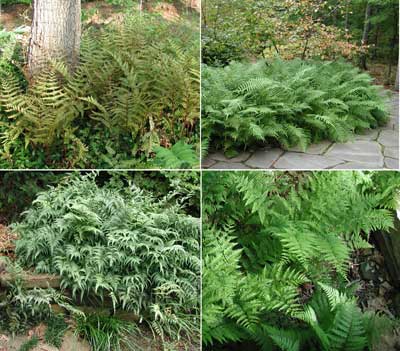Resource Library
Plant of the Week: Hardy Ferns
The University of Arkansas System Division of Agriculture does not promote, support or recommend plants featured in "Plant of the Week." Please consult your local Extension office for plants suitable for your region.
Plant of the Week
Hardy Ferns
Latin: Ferns

I have a fondness for ferns. I find something about their green lushness to be calming and soothing. They blend harmoniously with all other plants and always look right at home as long as the site is to their liking. And, if you find a spot to their liking, they live for years and become better each season.
I’ve been experimenting with growing hardy ferns in my dry, shaded Ozark hillside garden for 20 years and have learned a few things from the experience. I’ve learned most ferns do best in cool, moist shaded but bright locations in highly organic, acidic soils. Many will grow in soils and conditions less optimum than those described above but their size and performance will suffer.
Because hardy ferns tend to be long lived, the most successful ones will be those that tolerate the soil conditions that occur in your site because over time, no matter how much organic matter you incorporate, it will eventually break down and the ferns will have to survive with what was originally there.
Another thing I learned is that ferns test your patience. Don’t expect them to look like much the first year or two after planting. They take time to establish and it may be four or five years before you really get to see what a species has to offer. Unlike many flowering perennials that begin to slip after a few years, ferns only get better over time. Patience is a good thing.
Four ferns have done remarkably well in my shade garden. Two of these belong to the genus Dryopteris, a group of about 250 species of northern temperate ferns going by the common name of the woodferns. Of these I think D. erythrosa, the autumn fern from Asia, is the best landscape plant. I like it because it is evergreen and tough as nails. For me it grows about 16 inches tall and forms strong, 2-foot wide clumps. It gets its common name from the new springtime growth that is maroon red in color.
This fern has done well in dry shade, even growing at the base of an American elm for almost 20 years. The extreme heat and drought of 2011 and 2012 finally killed off the planting beneath the elm but the stand at the base of a post oak is still going strong. This species is happy in my garden, reproducing here and there by spores at the base of retaining walls.
Dryopteris ludoviciana, Southern woodfern, has done well in my dry shade, growing 24 to 30 inches tall and wide. In a moist site with deep, rich soil it can reach 4 feet in height. It is a handsome plant that is technically evergreen but the fronds lie flat on the ground during much of the winter so the effect is lost. D. marginata, the marginal woodfern native throughout the state has done well for me in dry shade planted in unamended soil, but plants are only about half as tall as the southern woodfern. I’ve tried 20 other Dryopteris and have found them to be easy to grow and adaptable of general garden conditions.
Another easy-to-grow group of ferns is in the genus Athyrium, the lady ferns. A. filix-femina, the true lady fern, is a variable plant popular during the Victorian fern craze. A number of dissected and oddly formed frond types are available. These fanciful forms are fun to grow and come true from spores, but probably the typical type is more useful in the average landscape. Lady in Red is most commonly offered with maroon-tinted stems when it emerges in the spring but is not much different than the species. It is an easy-to-grow, long-lived clump forming deciduous plant growing about two feet tall and wide in my dry shade.
But, as nice as our native lady fern is, its Japanese cousin, Athyrium nipponicum pictum - the Japanese painted fern - is really a better landscape plant. This fern looks too good to be true with its white-splashed fronds but it is incredibly easy to grow. It too is deciduous but its more showy fronds make it great in the shade garden where it brightens up dark corners. Use it as a mass planting for best effect. Japanese painted fern is not well suited to deep shade where it grows about 16 inches tall. This fern has spread about in my garden by spores so it is definitely happy.
The Ghost fern, a hybrid between the lady fern and the Japanese painted fern, is one of my favorite ferns. It has the neat, symmetrical form of the lady fern but the gray-white fronds of the Japanese painted fern. It’s kind of pricy, but I can imagine a large bed of this plant would make an eye-popping display.
By: Gerald Klingaman, retired
Retired Extension Horticulturist - Ornamentals
Extension News - August 2, 2013
The University of Arkansas System Division of Agriculture does not maintain lists of retail outlets where these plants can be purchased. Please check your local nursery or other retail outlets to ask about the availability of these plants for your growing area.